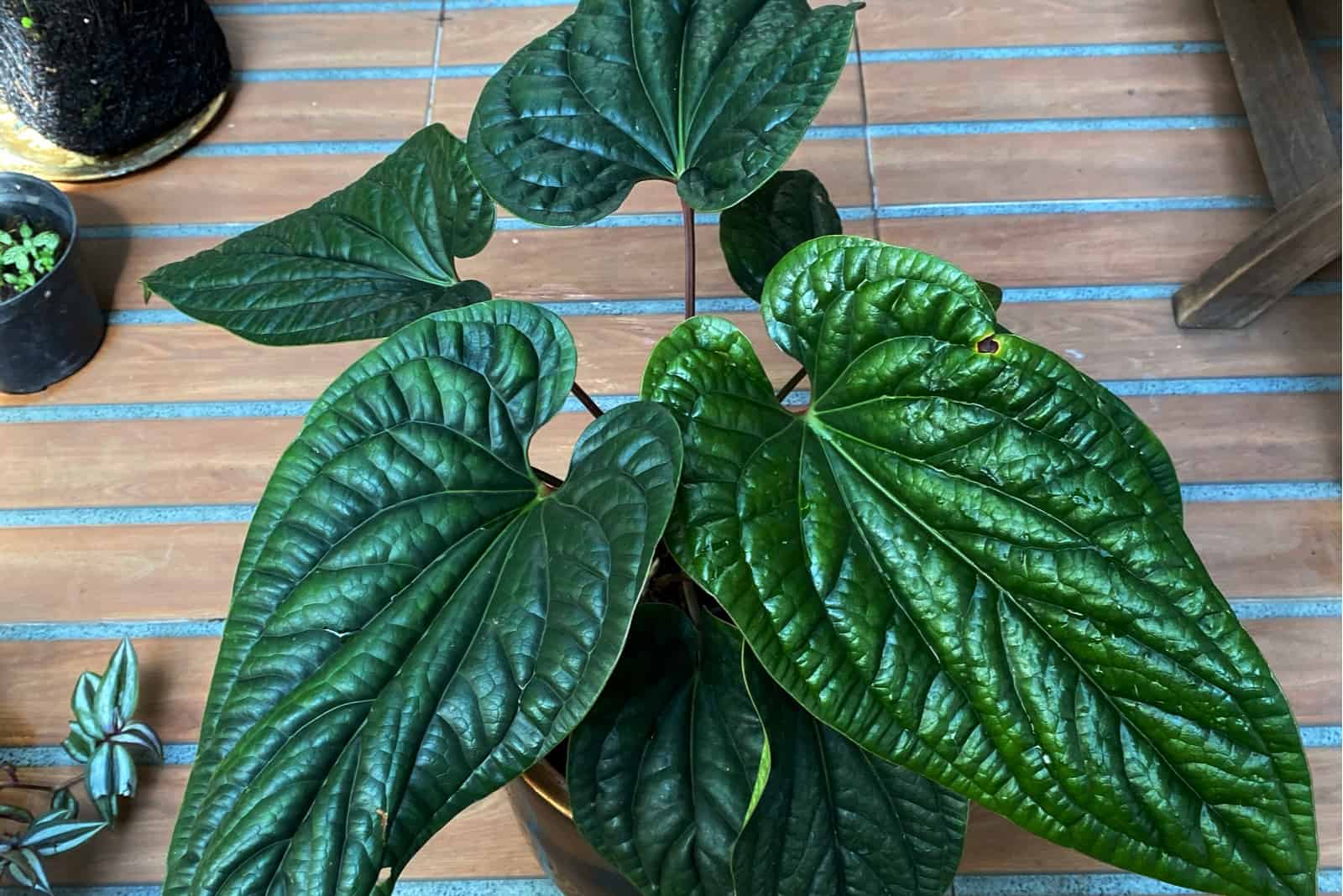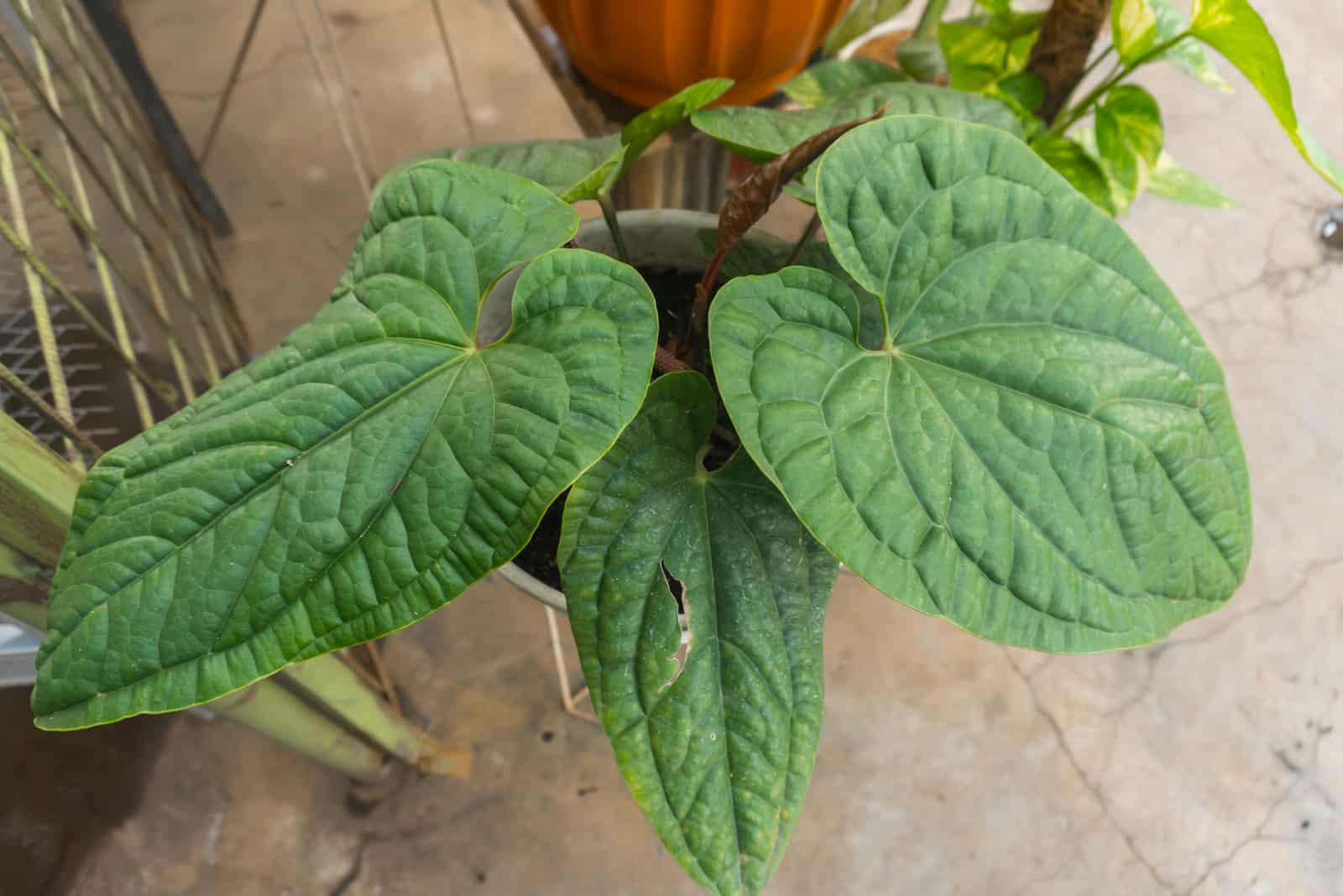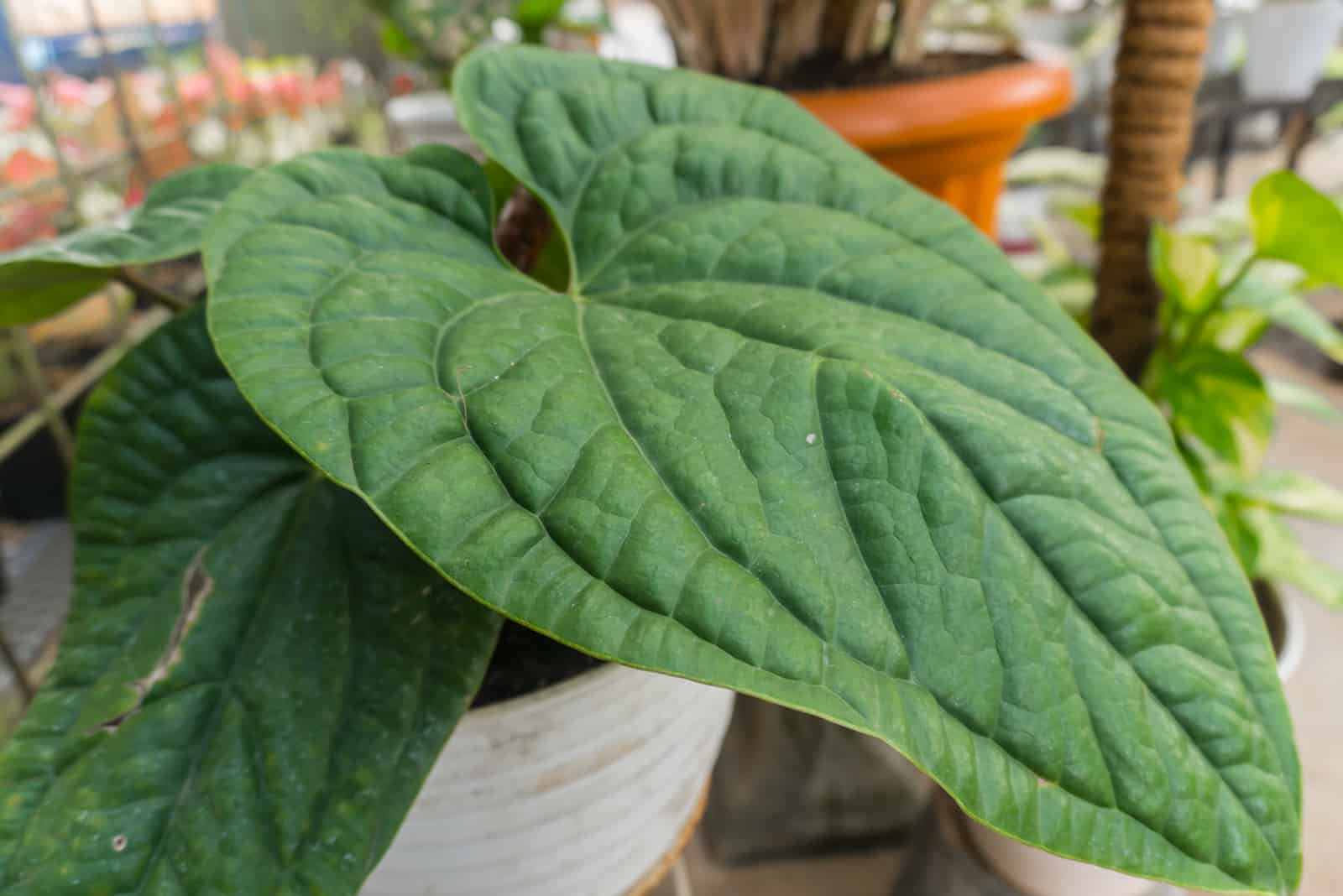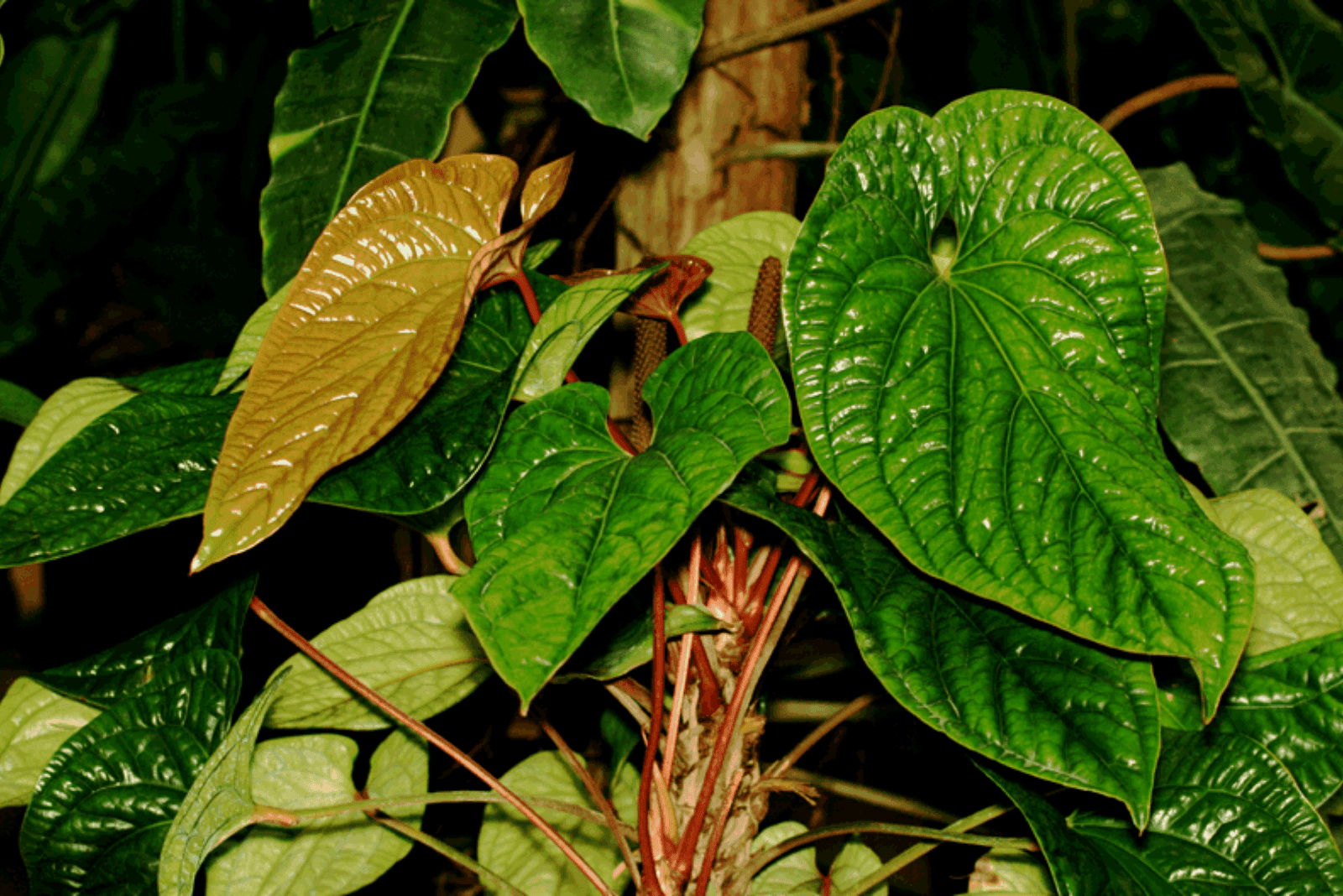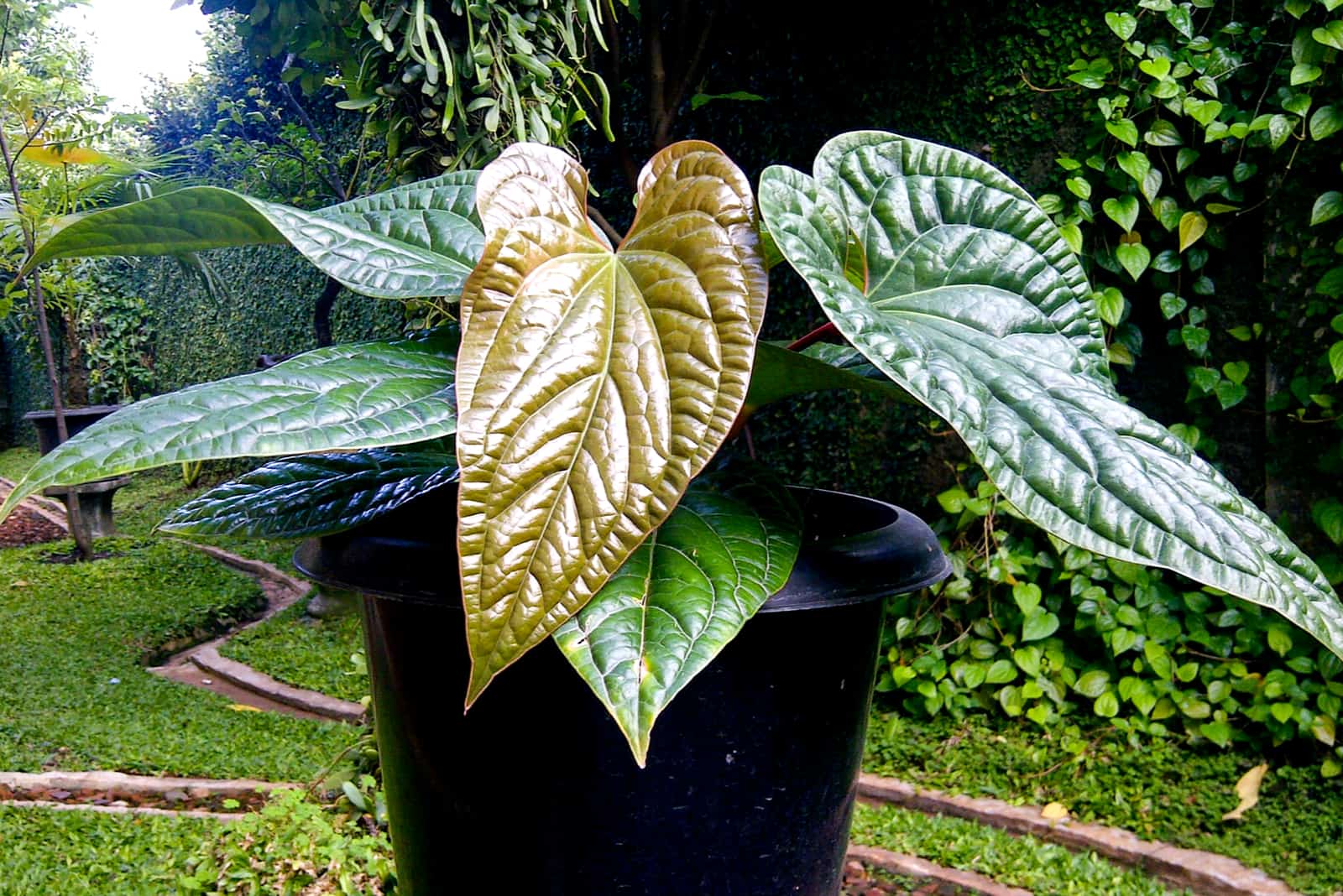Looking for an easy-to-grow and long-lasting houseplant? Meet the Anthurium Radicans, a plant with it all; it’s a stunning plant with heart-shaped leaves.
Another fascinating thing about this plant is its meaning; it symbolizes hospitality. This fact makes the Anthurium a perfect indoor plant.
It’s not a demanding plant; it appreciates mild temperatures, moist and well-draining soil, and moderate watering. What else should you look for?
Before we move on, let’s see some basic info:
[table id=110 /]What Does The Anthurium Radicans Look Like?
Let’s start with the leaves. Heart-shaped dark green leaves combine perfectly with flowers with maroon to purple spathes.
This is the smallest creeping Anthurium plant. It is often used to produce hybrids. Each hybrid species has impressive flowers, and this is why this Anthurium, and most of its hybrids, are so popular.
Anthurium species are known for their ability to produce both male and female organs on their flowers (self-pollinating).
The Anthurium Radicans stands out here. It’s actually not self-pollinating but relies on insects for pollination (the female flowers become receptive first).
Growth Rate
The Anthurium Malyi grows for the entire year. However, the plant only increases its size during the summer.
It can reach up to 20 inches, depending on the environment.
If you notice slower growth, you should check if there are any issues. This mainly happens when the roots outgrow the pot, and the plant will need to be repotted in this case.
There’s one rule about this Anthurium; the longer the spathe, the longer the stem.
This is a trailing plant, and you can expect its vines to spread up to 24 inches, this makes it perfect for hanging baskets and terrariums.
Blooms
The blooms last for about 3 months. Depending on the resemblance of its conditions to its native habitat, the plant can produce about 6 blooms.
Therefore, the more you mimic its natural habitat, the more likely the plant will produce more blooms. The conditions you need to ensure include the lightning, temperature, humidity, and soil.
Let’s dig deeper!
The Anthurium Radicans Care Guide
As the plant is easy to grow, you don’t need to expect any significant problems.
Let’s find out the ideal conditions you should meet to ensure the plant grows healthily and thrives.
Temperature Requirements
The plant comes from the tropical climates of Brazil. Therefore, it’s not strange that this Anthurium loves slightly higher temperatures (however, we don’t want to burn it).
The ideal temperature ranges from 70 to 90 °F.
However, this plant is adaptive and fortunately thrives in different temperature ranges. Though this doesn’t mean that the plant will thrive in very low temperatures.
Don’t let the temperature drop below 50 °F to avoid any damage to the way the plant looks. It can also grow slower or even stop growing at low temperatures.
I have to mention that extremely high temperatures will cause the moisture level to lower. That’s why it’s essential to keep the plant away from heating sources, such as fireplaces and radiators.
Light Requirements
The Anthurium Malyi is a tropical plant and it grows under the rainforest canopy. It won’t tolerate direct sun, and it needs about 75% light.
The plant thrives best in bright, indirect sunlight. Direct sunlight will cause the leaves and flowers to scorch. Additionally, the plant won’t grow as largeand will even produce fewer, smaller flowers.
If the Anthurium Radicans plant is placed near the window facing direct sunlight (if you can’t find another spot), put some curtain on the window to ensure partial shade.
If you grow this plant outside, put the plant under a tree to create shade during summer. On the other hand, the best option would be to keep the plant indoors during harsh winters.
Ensure a lot of indirect sunlight if the plant stays outside (only if temperatures during the winter aren’t too low).
Humidity Requirements
As Anthuriums are tropical plants, they prefer a high humidity. It should range from 60 to 80%.
To measure the humidity, you can use a hygrometer. That way, you will know if you need to increase the humidity. To increase the humidity, you can also use a humidifier.
There are also some natural ways to increase the humidity (I prefer these).
Using a pebble tray is a great way to naturally increase the humidity (DIY version).
Fill the tray with water and add pebbles; place the pot with the plant over the pebble tray.
Plant growers have one more hack for increasing the humidity. For example, if you grow philodendrons, place your Radicans plant next to them. This works well for other plants too, such as Monsteras or Peperomias. This is a great way to achieve the perfect humidity in a short time. Additionally, the humidity distribution will be even.
When it comes to the spot where you keep the plant, make sure it’s far away from air conditioners and vents as they dry the air and reduce humidity.
Another great thing about Radicans plants is that they will still grow well in a lower humidity for some time. Therefore, you’ll have enough time to ensure the humidity it needs to keep growing.
Water Requirements
Surprisingly, these Anthuriums are water-lovers, unlike the majority of other houseplants.
A general rule for watering Radicans is every 2 to 3 days. I suggest watering it when the top 2 inches of topsoil are dry.
As like every other houseplant, the watering needs will depend on your conditions. Therefore, a general rule for watering this plant can be applied in warmer climates.
Colder climates reduce watering needs; water when the soil dries out entirely.
I suggest you check the soil before watering, with one old but gold technique. Put your finger in the soil to inspect the moisture level.
Another way to measure moisture is to purchase a moisture meter.
Although the plant requires more watering than other common houseplants, it can still easily be overwatered. Overwatering will damage the leaves, and the damage can spread to other parts of the plant.
Also, avoid underwatering, as it will stunt growth and cause unnecessary problems.
Always check the soil before watering.
Soil
Adequate soil is an essential part of plant care. This aroid appreciates well-draining, moist, and organic soil.
If you already grow orchids, you can use your orchid mix. If you don’t, I recommend you purchase one to make your life easier. Orchid mix combined with sand or peat moss will give excellent results.
If you grow the plant indoors, add perlite to the potting soil and orchid mix to improve drainage.
The required pH level ranges from 6.1 to 6.5 (alkaline mix).
If you grow this plant outdoors, ensure a freely draining pot or soil.
Fertilization
Another plus for the Anthurium Radicans plant! It doesn’t require much fertilization.
To maintain healthy growth, you can fertilize the plant a couple of times per year (I find this ideal as I’m a little forgetful). Don’t spare on the fertilizer as you won’t need much (it will last a long time). Purchase high-quality fertilizer, rich in phosphorus.
This mineral will promote more blooms. Additionally, search for a fertilizer with lower amounts of salt added as the salt can cause root rot. Instead of a healthy, thriving plant, you’ll get a dying plant.
I fertilize my Radicans plant 3 times a year and use a slow-release fertilizer.
Apply fertilizer about 5 inches from the plant’s base; in this way, the fertilizer is allowed to spread evenly.
You don’t need to experiment with fertilizer; just purchase the one made explicitly for Anthuriums.
You should fertilize the plant during the growing season (spring and summer), which will speed up the growth and ensure a healthy plant.
Pruning
This Anthurium requires pruning from time to time, and the reason for this is the vines, which may look messy if they stay unpruned.
Choose any time of the year to prune your Anthurium Malyi.
There are 3 reasons for pruning. The first one is related to the appearance of the plant. Although the plant looks fantastic, it can change its looks if you let it grow uncontrollably.
This is especially important for dead and irregular leaves, which, in my opinion, don’t look ‘gorgeous’.
The second reason to prune this plant is to remove yellow or brown leaves. I have to mention that the leaves can turn yellow or brown due to low humidity or because they don’t have enough nutrients. Another common reason is that the plant has aged (it’s long-lasting but not eternal).
A third reason is to control the size. The plant can outgrow its pot; to avoid this, prune the vines that have started to peak through the pot’s holes. If you have a smaller living room, I assume you don’t want the entire room covered in Radicans’ vines (although it may look pretty).
You can prune with sharp scissors or any other cutting tool as long as it’s sharp.
Always sterilize the cutting tool before using it, this will help you avoid microbial infection, pests, and diseases. I use rubbing alcohol or bleach to sterilize my tools.
Repotting
The main reason for repotting this Anthurium is when it outgrows the pot. Although the plant has an average growth rate, an inadequate pot size can significantly reduce its growth.
Another not-so-common reason to repot is when the plant is drying up.
Radicans need repotting every 2 to 3 years if every ideal condition is ensured and the plant reaches 20 inches. The roots will peak from the drainage holes.
Make sure to purchase a slightly larger pot with drainage holes.
Why larger? More soil around roots, equals more moisture; this leads to root rot.
Let’s see the 4 steps for proper repotting.
1. Water the plant the day before repotting.
2. Take the plant out of the pot and gently shake off the roots (leave about half of the soil on the roots).
3. Plant the roots in the new pot. I suggest using a fresh potting mix each time you are repotting.
4. Press the soil down a bit to prevent air spaces and water the plant.
Propagation
The propagation process is relatively easy, and you will only need a couple of stem cuttings to get a new plant.
Before I tell you how to propagate, I have to mention a few things.
Always sterilize the cutting tool before using it, this will help you avoid microbial infection, pests, and diseases. I use rubbing alcohol or bleach to sterilize my tools.
You can wear protective clothing during the process to be safe.
After you complete the propagation process, stick to the usual care.
Propagation By Stem Cuttings
• Prepare a pot. I suggest you choose a pot 10 inches in diameter. Fill the pot with the appropriate potting mix. Make sure the pot has drainage holes.
• Select a couple of healthy stems and, using sterilized shears, cut the stems about 6 inches long. Make sure they have a few leaves attached.
• Poke a hole 2 to 3 inches long in the center of the soil. Use your finger or other garden tools, such as a garden spade, to make the hole.
• Put the cutting in the soil and add a potting mix to seal the space around the cutting. The leaves should not touch the soil so pull them off (do this gently as you don’t want to leave the stem without leaves).
• Water the soil. Moist soil will help the cutting to grow healthy.
• Water the soil every 2-3 days or when you notice dry topsoil. Remember, you should keep the soil moist, not waterlogged.
• Move the container into bright, indirect light. The new spot should be warm and have a high humidity.
New leaves and sprouted roots are the best indicator that it’s time to plant the roots in the pot you want them to stay in. The cutting will also be taller.
You can expect new growth after 4-6 weeks. Of course, it this time can be shorter or longer, depending on the conditions. If you want to speed up the process, you can dip the cuttings in a rooting hormone before you plant them.
Now it’s time to plant the roots into the original pot.
Cleaning
Cleaning is often forgotten in Flamingo plant care. Of course, cleaning is related to the leaves, and I pay more attention to cleaning the leaves of the plants that aren’t watered often.
But, like with every other thing in your house, the leaves can have dust on them.
I dip a cloth in water and gently rub the leaves. I leave them to dry afterward.
Many plant growers have other cleaning methods, however, I suggest only using water.
The Most Common Varieties
As mentioned, the Anthurium Radicans is often used to produce hybrids. The most common hybrids are the Salgarense, Radicans x Luxurians, and Radicans x Dressleri.
Let’s learn more!
The Anthurium Radicans x Luxurians
Anthurium Radicans x Luxurians is probably the most luxurious Anthurium hybrid that exists. These rare plants have elongated and more textured leaves.
The problem with this plant is that it’s hard to determine it. As it is more expensive (about $90) than many other Anthuriums, many sellers will try to fool you that you are buying a Radicans x Luxurians. Botanists use microscopes to check the inflorescences.
This plant has pinkish leaves that turn green as the plant matures.
The Anthurium Salgarense
The Salgarense is a very rare Anthurium. Most people haven’t heard of it at all. The Anthurium Sagarense has giant, beautiful, glossy light and dark green leaves.
If you grow this plant in a larger pot, it can grow up to 8 feet.
The Salgarense bloom is actually a spadix that has a foul smell.
The Anthurium Radicans x Dressleri
The Radicans x Dressleri is another rare Anthurium hybrid. It’s relatively hard to grow, and I wouldn’t recommend this plant to beginners.
Its giant heart-shaped leaves make the plant look amazing.
If you are lucky enough to find this plant, you will have to pay about $160.
Why Are Anthuriums So Expensive?
There are 2 reasons why Anthuriums are so expensive.
The first one is that the plants are rare. You may find Anthuriums in local plant stores, but you’ll have to pay more. If you compare these plants to other common houseplants on the shelves, you can see why they are so expensive. They undoubtedly look unique and special.
Another reason is that the Anthuriums are tropical plants. I’m sure you’ll ask yourself why tropical plants are more expensive than regular ones? The answer is transportation, as it will cost more to transport the plant from Brazil to Los Angeles than from San Francisco.
Many plant growers will say that these plants are worth every penny you spend on them.
Common Issues
The Anthurium Radicans plant isn’t prone to many diseases, but some may occur from time to time.
Let’s see what can go wrong.
Overwatering
These plants need to be watered more often when compared to other houseplants. This is why many think it’s impossible to overwater the plant.
It’s essential to water the plant only when the topsoil is dry. Overwatering can cause root rot that can lead to permanent damage.
Wet soil is an excellent environment for pathogens, mainly fungus. They destroy the root tissue, causing the roots to rot.
If you notice yellow leaves and mushy soil, inspect the root system.
If your plant suffers from root rot, the solution is to remove the roots that suffer from this disease.
Apply fungicide to the root system. Sterilize the shears and remove any affected roots.
Wash the roots and allow them to dry. Repot the plant after this.
Overfertilization
A. Radicans don’t need to be fertilized often, so it’s easy to over fertilize them.
If you notice brown leaf edges, you might be overfertilizing the plant.
Although a fertilizer rich in nitrogen can promote the growth of Radicans’ leaves, higher nitrogen concentrations can inhibit the blooming.
Purchase water-soluble fertilizer with a 1:2:1 (NPK) ratio.
Tenderness
This plant doesn’t withstand lower temperatures. If you live in colder climates, move the plant indoors during winter.
If you want this plant to grow outdoors, gradually increase the time it spends outside, and it should adapt within 3-4 weeks.
Pests
Although the Anthurium Malyi isn’t prone to pests, these annoying creatures can occur from time to time.
Spider mites are most likely to affect your plant. You’ll notice tiny white spots that seem to web if spider mites are to blame.
They mostly live on the undersides of the leaves, and if untreated, they can cause severe damage.
The first thing you should do if you notice spider mites is to isolate the plant. This way, you will prevent these annoying creatures from spreading onto your other plants.
You can remove these pests using insecticide. I prefer the natural way; gently rub the leaves with neem oil to remove the pests and eggs, as the eggs will restart the pests’ growth.
Is The Anthurium Radicans Toxic?
In my opinion, the Anthurium Radicans’ toxicity is the only negative aspect of this plant.
Yes, the plant is toxic to both humans and pets. Keep the plant away from small children and pets as the consumption of its leaves can cause several problems.
The Radicans’ leaves contain needle-like and sharp crystals of calcium oxalate. When ingested, the leaves release these crystals, causing swelling of the mouth or lips, or diarrhea.
FAQs
What is the most rare Anthurium?
The Anthurium Crystallinum, Anthurium Veitchii, and Anthurium Plowmanii are the rarest Anthurium plants. The Anthurium Crystallinum often mistaken for Clarinervium, has velvety green leaves with creamy-white veins. This is also one of the most wanted items for plant collectors. The Anthurium Veitchii is commonly known as the King Anthurium. It has elongated, glossy, and green leaves with a corrugated texture. The Plowmanii has sword-shaped leaves that are gently rippled along the edge.
What are the benefits of an Anthurium?
Anthuriums are air purifiers that remove harmful chemicals like ammonia, toluene, and formaldehyde.
According to the meaning behind Anthurium plants, they will bring luck to your relationship.
What are the different colors of anthurium plants?
Anthurium plants come in a range of colors. For example, the Anthurium Andreanum has red, waxy flowers, the Clarinervium’s are velvet, and the Anthurium Watermaliense’s are purple, almost black.
There are also pink, orange, yellow, brown, and blue Anthuriums.
Wrapping Up
Looking for an easy-to-grow, long-lasting, and stunning houseplant? Then, I suggest you get yourself an Anthurium Radicans.
You’ve learned about the main features of these plants and how to care for them. If some issues occur, you are now also well equipped to determine what the causes are and how to solve them.
Just make sure that the plant is away from children and pets as it’s toxic.
Until next time!
Like this post? Share or pin it for later!

